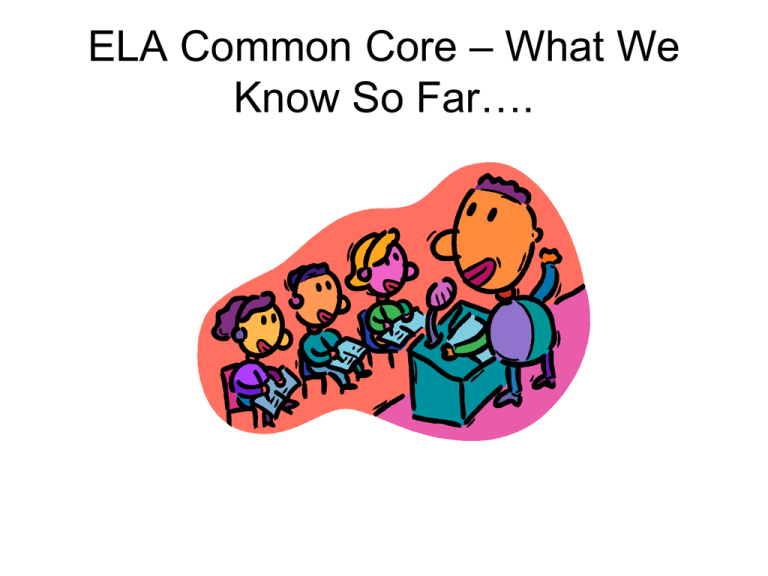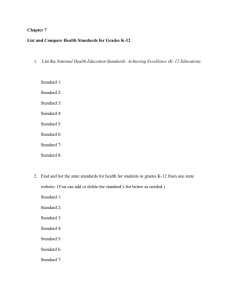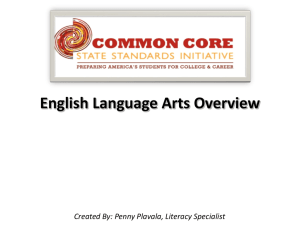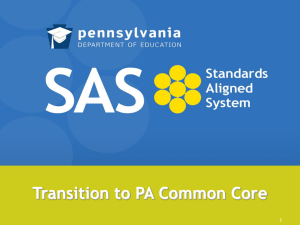Key Ideas and Details
advertisement

ELA Common Core – What We Know So Far…. English Language Arts • • • • Reading – Literature Reading – Informational Text Writing Speaking and Listening Major Shifts from SCS • Text Complexity – lots of Informational Text and more complex Literature • Students must analyze, infer, and give evidence • Writing from sources – read text, analyze, put thoughts into writing • Mastery of writing and speaking • Academic vocabulary – words that are hard to put definitions with Project Oriented • Presenters made the comparison to Grad School • Students will be expected to present research • Text based answers • Mastery of Writing and Speaking • Writing – creativity in their arguments rather than narrative based • We want our students to read like a detective and write like an investigative reporter. New Blooms….really?! • • • • Verbs and questions stems on key rings Write lesson plans Post kid-friendly objectives Takes focus off what teacher will do and turns it into what the STUDENTS will do. • Let students generate questions using the stems in an activity station Costa’s House • Three Story Intellect: • Basement – remembering, understanding • Ground floor – applying, analyzing • Penthouse – evaluating, creating 10 Anchor Standards *Same for K-12 • Key Ideas and Details -Read closely to determine what the text says explicitly and to make logical inferences from it; cite specific textual evidence when writing or speaking to support conclusions drawn from text. -Determine central ideas or themes of a text and analyze their development; summarize the key supporting details and ideas. -Analyze how and why individuals, events, and ideas develop and interact over the course of a text. 10 Anchor Standards *Same for K-12 • Craft and Structure -Interpret words and phrases as they are used in a text, including determining technical, connotative, and figurative meanings, and analyze how specific word choices shape meaning or tone. -Analyze the structure of texts, including how specific sentences, paragraphs, and larger portions of the text (a section, chapter, scene, or stanza) relate to each other and the whole. -Assess how point of view or purpose shapes the content and style of a text. 10 Anchor Standards *Same for K-12 • Integration of Knowledge and Ideas -Integrate and evaluate content presented in diverse media and formats, including visually and quantitatively, as well as in words. -Delineate and evaluate the argument and specific claims in a text, including the validity of the reasoning as well as the relevance and sufficiency of the evidence. -Analyze how two or more texts address similar themes or topics in order to build knowledge or to compare the approaches the authors take. 10 Anchor Standards *Same for K-12 • Range of Reading and Level of Text Complexity -Read and comprehend complex literary and informational texts independently and proficiently. Vertical Alignment Activity • Each person at the table take all of the sheets of a color from the baggie – you should have 6 different small sheets. • Place the sheets in order from kindergarten through fifth grade Key Ideas and Details - Literature • Kindergarten: With prompting and support, identify characters, settings, and major events in a story Key Ideas and Details - Literature • First Grade: Describe characters, settings, and major events in a story, using key details Key Ideas and Details - Literature • Second Grade: Describe how characters in a story respond to major events and challenges Key Ideas and Details - Literature • Third Grade: Describe characters in a story (e.g. their traits, motivations, or feelings) and explain how their actions contribute to the sequence of events Key Ideas and Details - Literature • Fourth Grade: Describe in depth a character, setting, or event in a story or drama, drawing on specific details in the text (e.g. a character’s thoughts, words, or actions) Key Ideas and Details - Literature • Fifth Grade: Compare and contrast two or more characters, settings, or events in a story or drama, drawing on specific details in text (e.g. how characters interact) Crosswalks • This document shows the connection between the current Standard Course of Study and the Common Core • You need to just get in there and check it out • http://www.ncpublicschools.org/acre/stand ards/common-core-tools/ Unpacking Documents • Breaks down the standard into essential questions and provides task analysis • This seems to be the most valuable resource • http://www.ncpublicschools.org/acre/stand ards/common-core-tools/ What about THE TEST?? • Grade 3 Reading for Literature 32 – 37 % Reading for Information 41 – 45 % Language 20 – 24 % What about THE TEST?? • Grade 4 Reading for Literature 30 – 34 % Reading for Information 45 – 49 % Language 19 – 21 % What about THE TEST?? • Grade 5 Reading for Literature 36 – 40 % Reading for Information 29 – 33 % Language 29 – 31 % Pacing Guides on the way • According to Sandra Evans, we will have pacing guides in hand before the start of the new school year. • Great unit example for 2nd grade on • http://commoncore.org/maps/membership/ samples





